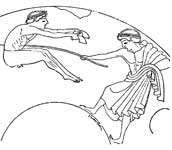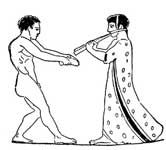.

|

|

|
 |
Click Images to Enlarge
The term halteres comes from the Greek word for dumbbells. In ancient Greek sports, halteres were used as lifting weights, and also as weights in their version of the long jump, which was probably a set of three jumps. Halteres were held in both hands to allow an athlete to jump a greater distance; they may have been dropped after the first or second jump. According to archaeological evidence, the athlete would swing the weights backwards and forwards just before take-off, thrust them forwards during take-off, and swing them backwards just before releasing them and landing.
Halteres were made of stone or metal, and weighed between two and nine kilograms. Writing in Nature, biophysicist Alberto E. Minetti of Manchester Metropolitan University calculates that halteres added about 17cm to a 3m long jump. (ref: Nature 420, 141 - 142 (14 November 2002).)
THE HALTERES-JUMP (PDF File)
| Ancient Greece
Science, Technology , Medicine , Warfare, , Biographies , Life , Cities/Places/Maps , Arts , Literature , Philosophy ,Olympics, Mythology , History , Images Medieval Greece / Byzantine Empire Science, Technology, Arts, , Warfare , Literature, Biographies, Icons, History Modern Greece Cities, Islands, Regions, Fauna/Flora ,Biographies , History , Warfare, Science/Technology, Literature, Music , Arts , Film/Actors , Sport , Fashion --- |
Retrieved from "http://en.wikipedia.org/"
All text is available under the terms of the GNU Free Documentation License
